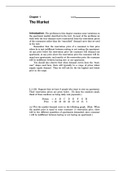Chapter 1 NAME
The M arket
Introduction. The problems in this chapter examine some variations on
the apartment market described in the text. In most of the problems we
work with the true demand curve constructed from the reservation prices
of the consumers rather than the “smoothed” demand curve that we used
in the text.
Remember that the reservation price of a consumer is that price
where he is just indifferent between renting or not renting the apartment.
At any price below the reservation price the consumer will demand one
apartment, at any price above the reservation price the consumer will de-
mand zero apartments, and exactly at the reservation price the consumer
will be indifferent between having zero or one apartment.
You should also observe that when demand curves have the “stair-
case” shape used here, there will typically be a range of prices where
supply equals demand. Thus we will ask for the the highest and lowest
price in the range.
1.1 (3) Suppose that we have 8 people who want to rent an apartment.
Their reservation prices are given below. (To keep the numbers small,
think of these numbers as being daily rent payments.)
Person = A B C D E F G H
Price = 40 25 30 35 10 18 15 5
(a) Plot the market demand curve in the following graph. (Hint: When
the market price is equal to some consumer i’s reservation price, there
will be two different quantities of apartments demanded, since consumer
i will be indifferent between having or not having an apartment.)
,2 THE MARKET (Ch. 1)
Price
60
50
40
30
20
10
0 1 2 3 4 5 6 7 8
Apartments
(b) Suppose the supply of apartments is fixed at 5 units. In this case
there is a whole range of prices that will be equilibrium prices. What is
the highest price that would make the demand for apartments equal to 5
units? $18.
(c) What is the lowest price that would make the market demand equal
to 5 units? $15.
(d) With a supply of 4 apartments, which of the people A–H end up
getting apartments? A, B, C, D.
(e) What if the supply of apartments increases to 6 units. What is the
range of equilibrium prices? $10 to $15.
1.2 (3) Suppose that there are originally 5 units in the market and that
1 of them is turned into a condominium.
(a) Suppose that person A decides to buy the condominium. What will
be the highest price at which the demand for apartments will equal the
supply of apartments? What will be the lowest price? Enter your an-
swers in column A, in the table. Then calculate the equilibrium prices of
apartments if B, C, . . . , decide to buy the condominium.
, NAME 3
Person A B C D E F G H
High price 18 18 18 18 25 25 25 25
Low price 15 15 15 15 18 15 18 18
(b) Suppose that there were two people at each reservation price and 10
apartments. What is the highest price at which demand equals supply?
18. Suppose that one of the apartments was turned into a condo-
minium. Is that price still an equilibrium price? Yes.
1.3 (2) Suppose now that a monopolist owns all the apartments and that
he is trying to determine which price and quantity maximize his revenues.
(a) Fill in the box with the maximum price and revenue that the monop-
olist can make if he rents 1, 2, . . ., 8 apartments. (Assume that he must
charge one price for all apartments.)
Number 1 2 3 4 5 6 7 8
Price 40 35 30 25 18 15 10 5
Revenue 40 70 90 100 90 90 70 40
(b) Which of the people A–F would get apartments? A, B, C, D.
(c) If the monopolist were required by law to rent exactly 5 apartments,
what price would he charge to maximize his revenue? $18.
(d) Who would get apartments? A, B, C, D, F.
(e) If this landlord could charge each individual a different price, and he
knew the reservation prices of all the individuals, what is the maximum
revenue he could make if he rented all 5 apartments? $148.
(f ) If 5 apartments were rented, which individuals would get the apart-
ments? A, B, C, D, F.
1.4 (2) Suppose that there are 5 apartments to be rented and that the
city rent-control board sets a maximum rent of $9. Further suppose that
people A, B, C, D, and E manage to get an apartment, while F, G, and
H are frozen out.
, 4 THE MARKET (Ch. 1)
(a) If subletting is legal—or, at least, practiced—who will sublet to whom
in equilibrium? (Assume that people who sublet can evade the city rent-
control restrictions.) E, who is willing to pay only
$10 for an apartment would sublet to F,
who is willing to pay $18.
(b) What will be the maximum amount that can be charged for the sublet
payment? $18.
(c) If you have rent control with unlimited subletting allowed, which of
the consumers described above will end up in the 5 apartments? A,
B, C, D, F.
(d) How does this compare to the market outcome? It’s the
same.
1.5 (2) In the text we argued that a tax on landlords would not get
passed along to the renters. What would happen if instead the tax was
imposed on renters?
(a) To answer this question, consider the group of people in Problem 1.1.
What is the maximum that they would be willing to pay to the landlord
if they each had to pay a $5 tax on apartments to the city? Fill in the
box below with these reservation prices.
Person A B C D E F G H
Reservation Price 35 20 25 30 5 13 10 0
(b) Using this information determine the maximum equilibrium price if
there are 5 apartments to be rented. $13.
(c) Of course, the total price a renter pays consists of his or her rent plus
the tax. This amount is $18.
(d) How does this compare to what happens if the tax is levied on the
landlords? It’s the same.





